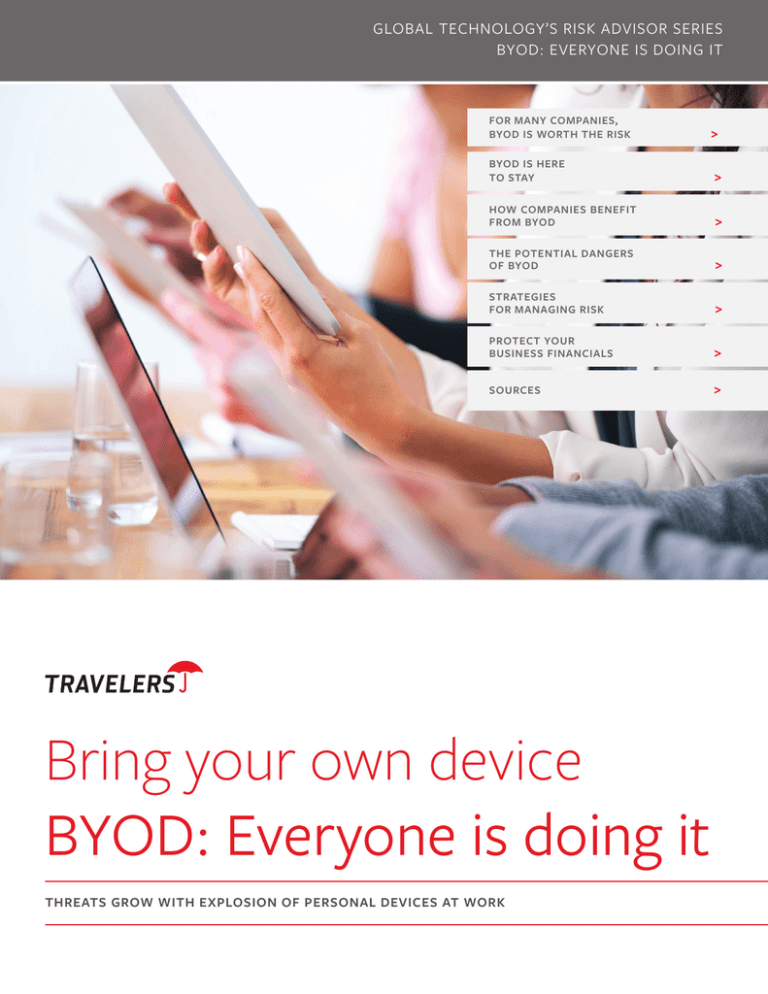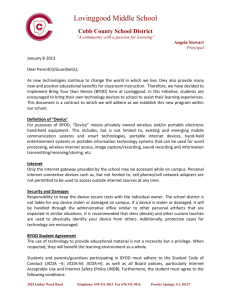
GLOBAL TECHNOLOGY’S RISK ADVISOR SERIES
BYOD: EVERYONE IS DOING IT
FOR MANY COMPANIES,
BYOD IS WORTH THE RISK
BYOD IS HERE
TO STAY
>
>
HOW COMPANIES BENEFIT
FROM BYOD
>
THE POTENTIAL DANGERS
OF BYOD
>
STRATEGIES
FOR MANAGING RISK
>
PROTECT YOUR
BUSINESS FINANCIALS
>
SOURCES >
Bring your own device
BYOD: Everyone is doing it
THREATS GROW WITH EXPLOSION OF PERSONAL DEVICES AT WORK
For many companies, BYOD is worth the risk
At one time, people scoffed at the idea of a personal computer
in every home. Today, we not only have high-speed Internet
available in our homes, but we also connect to the Internet at
will with a variety of mobile devices from wherever we happen to
be. Tomorrow, we will be wearing Google glasses that allow us to
instantly access all the information we need about anything that
can be imagined.
The ubiquity of personal devices is changing the way the
corporate world operates. Businesses once built strong firewalls
to block external access, banned employees from backing up
their work on portable hard drives and allowed connectivity only
through company-issued devices. Today, eager to hold down
costs and happy to take advantage of well-connected employees,
some of these same businesses are adapting their policies to
embrace Bring Your Own Device (BYOD). But many more are
simply standing by as employees incorporate BYOD into their
work lives, without waiting for permission or policies.
Unfortunately, the online-all-the-time reality that employees
are creating opens the door to risks and costs that companies
should be managing. This is true for businesses across all
industries, but even more so for technology companies that
may get caught in the crossfire when mobile devices go rogue
or provide a gateway for cybercrime. No company can afford
travelers.com
to have its own employees be careless with corporate data, but
technology companies may also be at risk of liability if products
they sold or services they provide are seen as failing to protect
customers or contributing to a security breakdown.
In this issue of our Risk Advisor series, we look at both the
upside and downside of allowing employees to use their own
devices. Topics covered include:
•
For many companies, BYOD is worth the risk
•
BYOD is here to stay
•
How companies benefit from BYOD
•
The potential dangers of BYOD
•
Strategies for managing risk
•
Protect your business financials
With BYOD becoming widespread, it is important for
businesses to be proactive about personal device risk
management. Our hope is that this Risk Advisor paper will
help companies chart a path for creating the most effective
corporate policies and protections.
– Mike Thoma
Chief Underwriting Officer of Global Technology at Travelers
FOR MA N Y COMPA N IES, BYOD IS WORT H T HE RISK
PAG E
1
BYOD is here to stay
Pulling out a mobile device to check email used to be a privilege
of rank – corporations passed out Blackberries to top executives
and high-performing employees. Today, if a company provides a
mobile device, it is likely to be the second (after a personal smartphone)
or third one (after a tablet) the employee uses. As such, it may be
viewed as more of a nuisance than a perk, with employees complaining of
having to carry multiple devices to keep up with both their work and personal lives.
From the employee side, the solution seems obvious – use their
own mobile devices to perform work functions. And indeed, that
is what 81 percent of employees questioned in a 2012 Harris
Interactive survey say they do.
The reasons go beyond the inconvenience of carrying multiple
devices and switching from one device to another. Employees
often replace their personal devices more quickly than
corporations upgrade their equipment, spurred into getting the
most current model by subsidies from service providers. There is
also competitive consumerism – many don’t want to be the last to
own the newest smartphone. This means their personal devices
are often faster, more functional and just plain more fun than
whatever their employer is passing out.
In addition, employees today see 24-hour availability as more
normal than in the past, when the standard was to have an
eight-hour workday and a distinctly separate time for a private life.
The overlap of work and personal time has resulted in a desire by
employees to connect to work at any time from any place, at their
own convenience.
The functionality that employees gain by using their own devices
also makes BYOD attractive to them. Corporate IT departments
often limit the size of attachments that can be emailed or content
that can be stored as a way of improving the efficiency of servers
or holding down the cost of adding storage capacity. When
employees combine the use of their own devices with cloud-based
applications like Google Drive and Drop Box, they avoid limits and
increase their ability to work seamlessly with their colleagues. So
BYOD makes sense to employees, particularly if the company is
willing to subsidize some of the personal cost. For businesses, the
BYOD issue is less clear.
travelers.com
Nearly two-thirds of employees told Harris Interactive that their
companies have no policies regarding the use of personal mobile
devices. In contrast, a separate report by Trustwave found that
26 percent of companies forbid access to corporate data with
personal devices, 33 percent have no official policy but tolerate
the use, and 41 percent have a formal BYOD policy that dictates
how, when and where personal devices can be used.
While it is mathematically possible that the 66 percent of surveyed
employees who say their companies have no policy all work at the
33 percent of companies that have no policies but tolerate use,
it is much more likely that many employees use their personal
devices in either ignorance or defiance of corporate policies.
Regardless of the corporate perspective of the potential impact
of BYOD, the reality is that employees are already using their
personal devices. In fact, a white paper by Osterman Research
released in April 2013 found that the majority of both iPhones and
Android phones used for corporate business are owned personally
rather than by the corporation.
There is little reason to believe the popularity of BYOD will wane
anytime soon – especially in light of the upside for both employees
and corporations.
BYOD IS HERE TO STAY PAG E
2
How companies benefit from BYOD
Business thrives on increased
productivity – getting more
out of assets without increasing
incremental costs. For most
companies, their most valuable asset
is their workforce, and finding a way
to keep employees engaged after
hours is an opportunity to increase
productivity. BYOD facilitates anytime/
anywhere connection with employees,
encouraging them to keep in touch
with communications from work and
allowing them to access corporate
data at any time.
Another truism is that companies that encourage
teamwork and collaboration are more successful than
those that do not. BYOD increases opportunities
for teams to work together and communicate more
clearly, without barriers of time zones or geography.
Employees located around the globe are less
constrained about communicating when they can
ignore the eight-hour workday and reach out to their
colleagues on personal devices.
The reduction in corporate cost is also another big
benefit of BYOD. A May 2013 report by Gartner puts the
average cost of supplying mobile computing devices at
$600 annually per employee, an expensive undertaking
for mid-size and large employers. This more than offsets
the estimated $100 to $300 added costs for security or
employee compensation for BYOD programs. While some
corporations compensate some workers, at least partially,
for the use of their personal device, many do not. Gartner
reports that only about half of BYOD programs provide
compensation, usually for the service plan rather than for
the cost of the device. Only 2 percent cover all costs.
Finally, employee satisfaction, motivation and innovation
are strongly linked to the ability to use their own devices.
A 2012 Unisys report found that 44 percent of employees
find a job offer more attractive if they know the use of their
personal iPads are supported at work.
Between employee pressure and the benefits to
corporations, many expect the use of BYOD to grow.
Gartner predicts that by 2017, almost half of the world’s
companies will no longer provide computing devices to
employees, while another 40 percent will offer a choice
of corporate or personal equipment. The report says the
remaining 15 percent will never move to a BYOD model.
travelers.com
HOW COMPA N IES BEN EFIT FROM BYOD
PAG E
3
The potential dangers of BYOD
The answers to the Harris Interactive survey demonstrate why BYOD is a problem:
31 PERCENT
46 PERCENT
33 PERCENT
25 PERCENT
connect to their
company’s network
from unsecured free
or public wi-fi.
share their personal
devices with others,
opening the door to
unintended access to
corporate data.
say the company
data they use
and store is not
encrypted.
have been a victim of
hacking or malware
on their personal
devices.
A free flow of information and round-the-clock connectivity
benefits corporations in many ways, but BYOD is a mixed
blessing. When corporations lack control of their data, the
possibility that something will go wrong increases, as does the
cost of addressing whatever has gone wrong.
For example, an employee who uses a personal tablet to work
on company spreadsheets may lose the device (at just seven
airports, 7,000 mobile devices were left behind during one
12-month period, according to Trustwave). The employee
may upgrade to a different device without wiping clean the
hard drive of the prior one, or share it with a spouse or friend
who has no authorization to view the information. Among the
problems this could cause:
•
•
•
•
Businesses that are tightly regulated in terms of retaining
data or keeping it private (particularly in the financial
services and health care industries) are subject to fines,
liability lawsuits and remediation costs when data security
is breached, even if the breach occurs on an employee’s
personally owned device.
The incursion of hackers or spread of malware into
the company’s database can come through public wi-fi
connections used by an employee or infected applications
that the employee downloads. Many employees are also lax
about security, failing to update their operating systems or
install effective anti-virus software on their personal devices.
Trustwave reports that 90 percent of Android users have
not updated their operating system and 37 percent have
not activated their auto-lock feature. More than half of
companies with a BYOD policy in place report they have
experienced a mobile data breach, according to Trustwave.
A Symantec survey found that over a 12-month period,
43 percent of organizations reported malware infections
from mobile devices.
The risk that an employee sitting at a desk using a computer
mouse will develop a repetitive stress injury can be managed
by ergonomic best practices. But what is the liability for
travelers.com
Statistics like these
are frightening for
security-conscious
corporate IT teams.
a company if an employee files a workers compensation
claim based on an injury from the overuse of a personal
device that is used for both work and pleasure? In 2012,
InformationWeek reported two such claims had been made.
Other problems can occur when an employee no longer works
for a company, either by voluntary or involuntary separation.
The employee may forget to transfer data from the personal
device to the corporate database before departing or may
intentionally misuse information stored on a personal device
after separation. The loss of control over their own information
should be a major concern for corporations, especially those
that are required by law to archive and retain information for a
certain number of years.
In addition, a variety of legal complications can arise from
BYOD, many of which can dramatically increase the cost of
responding to lawsuits or government subpoenas. Discovery
demands can be broad enough to include all devices used
by employees, including their own, whether or not BYOD is
allowed by corporate policy. Each device increases the amount
of data to be reviewed, which drives legal bills higher.
Technology companies that provide services or products to
their customers also may see increased exposure to risk when
companies allow BYOD. If they provide security software that
fails to block a virus or malware that infects the customer’s
network through an employee’s personal device, they may face
a claim for damages.
Finally, employees often are unaware of their own risk from
using their personal devices. For instance, in the event of
discovery demands connected to a lawsuit against their
employer, all of their data – both work-related and personal
– can be exposed to examination. They may also feel unduly
constricted by corporate policies that forbid the downloading
of unapproved applications on their personal devices,
especially if they are receiving no or little compensation from
the company to subsidize the cost of their device.
T HE POT EN T IA L DA N G ER S OF BYOD
PAG E
4
Strategies for managing risk
The most complete and effective defense against the risks of BYOD is to ban employee use of
personal devices for work-related activities. However, abstinence can be a tough sell to employees,
and non-compliance can be difficult to control. The smarter approach is to put a strong policy in place,
educate employees about best practices and take actions that will manage the risk as much as possible.
1.
Policy elements – A company’s BYOD policy may include what type of
devices are allowed to be used, how employees may use devices to connect to corporate
networks (such as always using a secured wi-fi connection) and what applications are
approved for use, including both downloadable apps and cloud-based tools. It can also
set expectations, such as the company making clear it has no responsibility for lost or
damaged personal devices or employee injury from misuse of a personal device. In
addition, it can restrict the type of data that can be transferred to personal devices,
as well as set out protocols for data synchronization and backup. Finally, it can require
employees to install the latest operating system updates, corporate-designated anti-virus
software, encryption software and remote data wiping capability.
2.
Employee training – Employees should receive training on best
practices for data security. The goal is to have them not only understand all of the
elements of the corporate BYOD policy but to also realize the exposure to risk and
the consequences if they fail to take the prescribed precautions. For example, few
employees are aware that 87 percent of mobile applications tested had one or
more security flaws, according to Trustwave, including transmitting sensitive data
automatically. When training is complete, employees should know how to access
corporate data from their personal devices, which applications are risky and which
are safe to use, how to separate work and private data on their devices, and what
types of work activities are appropriate for BYOD.
3.
Risk management – Striking a balance between restrictions to
protect the corporate network and the flexibility that will allow employees
to use personal devices productively is key. Types of personal devices and
applications should be vetted for risk so that companies can make sound
decisions about approved BYOD usage. Corporate network protection should
be updated with personal device use in mind, including requiring a two-step
process for authentication to access the corporate system that recognizes not
just the device but also the person using it. Software tools should be in place
that allow remote wiping of data, scanning for malware and data leakage, and
archiving of corporate data.
travelers.com
ST RAT EG IES FOR MA N AG IN G RISK
PAG E
5
Protect your business financials
A Symantec survey found that the majority of companies
believe the benefits of BYOD outweigh the risks – but the
risks are real. More than half of the companies reported at
least one mobile security incident over a 12-month period,
including lost or stolen devices (60 percent), spam
(60 percent), malware infections (43 percent), phishing
attacks (40 percent) and exposure of confidential
information (19 percent). Clearly, mitigating exposure
to risk is critical.
One important tool is cyber security insurance. These
specialized policies go beyond general corporate liability
policies, offering specific coverage to address cyber
exposures. The best policies include:
•
•
•
Errors and Omissions
Coverage that protects a business that sells products
and services to others when claims are made about their
failure to block cyber intrusions.
Data Breaches
Coverage that takes care of the cost of breach
notification, public relations crisis management services,
credit repair services, etc.
Network Impairment
Coverage that addresses losses due to hacking, denial of
service attacks and other forms of cybercrime.
Working closely with a knowledgeable broker is the best way
to identify the right cyber policy to cover the risks that a
company faces.
travelers.com
An evolving world
As mobile devices continue to develop and
adoption of BYOD becomes even more
prevalent in the work world, new security
features and capabilities are likely to emerge.
In the meantime, businesses should assess
the risk-versus-benefit status of BYOD in their
corporate environment, adopt strong policies
that protect them while encouraging employee
productivity, and take steps to mitigate the
inevitable risk that BYOD brings.
PROT ECT YOU R BU SIN ES S FIN A N CIA LS
PAG E
6
SOURCES
Gartner research
http://www.pcworld.com/article/2036980/half-of-companies-will-require-byod-by-2017-gartner-says.html
Harris Interactive survey
http://www.welivesecurity.com/2012/04/04/byod-infographic-for-security-not-a-pretty-picture/
InformationWeek
http://www.informationweek.com/mobile/6-%20risks-your-byod-policy-must-address/d/d-id/1107451?page_number=2
Legal risks
http://www.informationweek.com/smb/mobile/6-risks-your-byod-policy-must-address/240142320
Osterman research
http://www.ostermanresearch.com/whitepapers/download179
Trustwave graphic
https://www.trustwave.com/trustednews/2013/04/infographic-the-high-cost-byod#sthash.vpLp3nzr.dpbs
Symantec survey
http://www.symantec.com/connect/blogs/survey-despite-security-incidents-byod-worth-risks
travelers.com
The Travelers Indemnity Company and its property casualty affiliates. One Tower Square, Hartford, CT 06183
This material is for informational purposes only. All statements herein are subject to the provisions, exclusions and conditions of the applicable policy. For an actual description of all coverages, terms
and conditions, refer to the insurance policy. Coverages are subject to individual insureds meeting our underwriting qualifications and to state availability.
© 2015 The Travelers Indemnity Company. All rights reserved. Travelers and the Travelers Umbrella logo are registered trademarks of The Travelers Indemnity Company in the U.S. and other countries.
CP-8219 New 1-15




